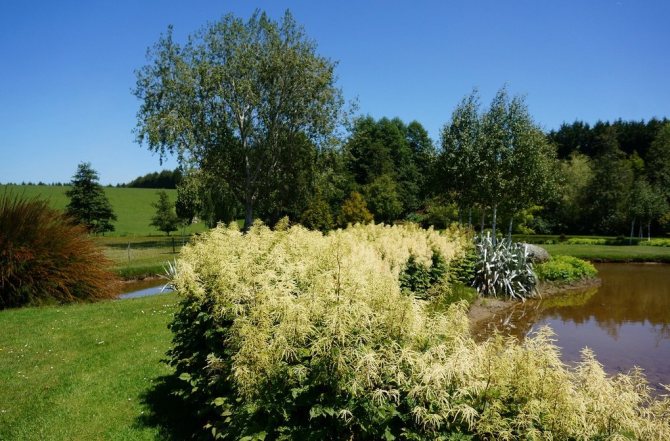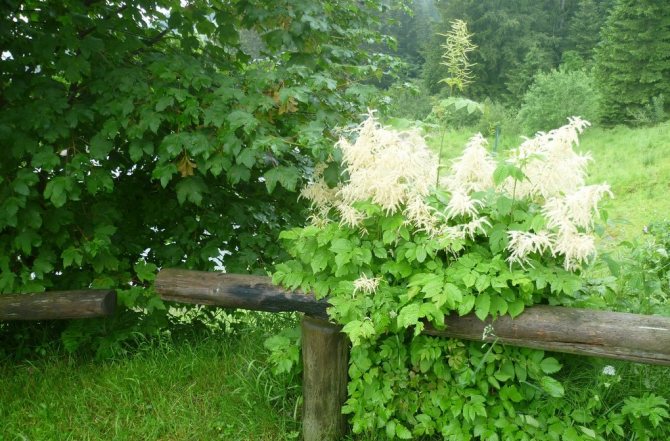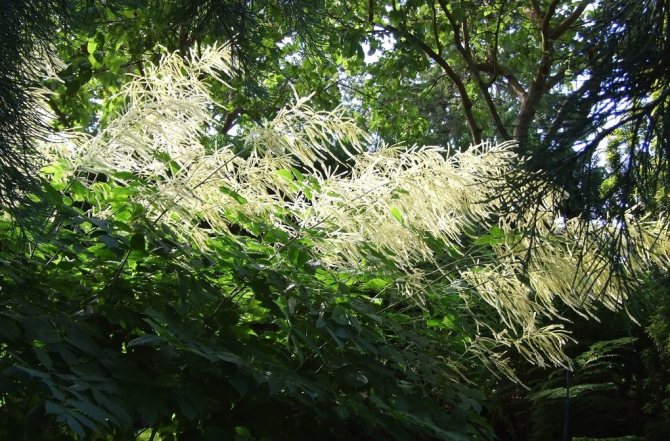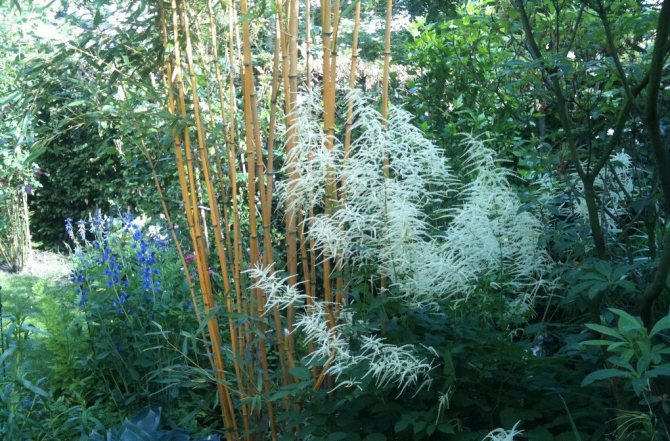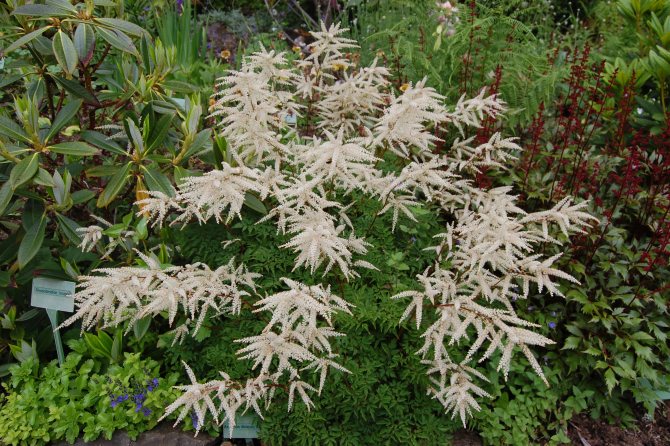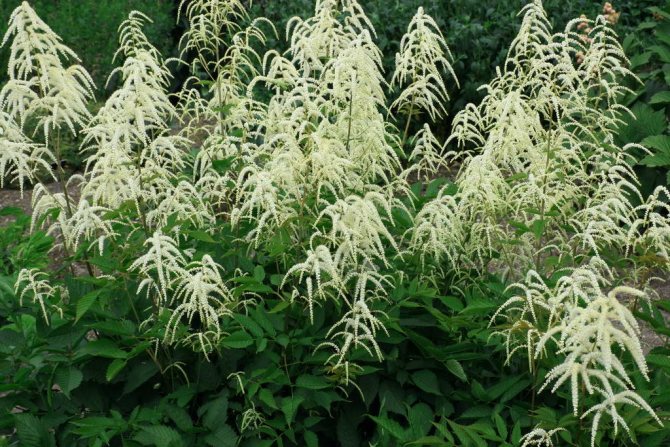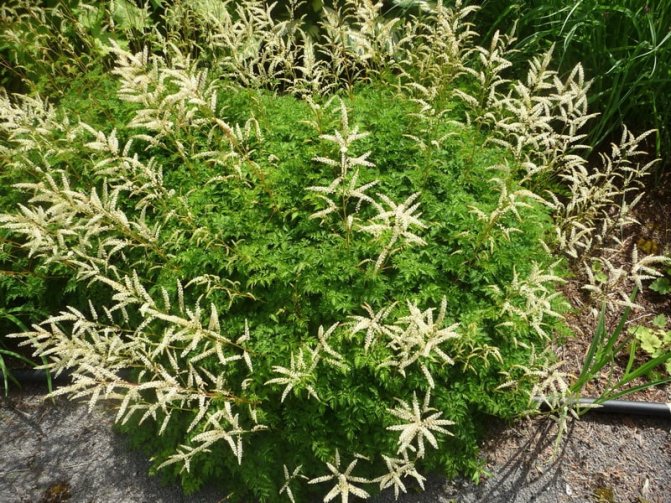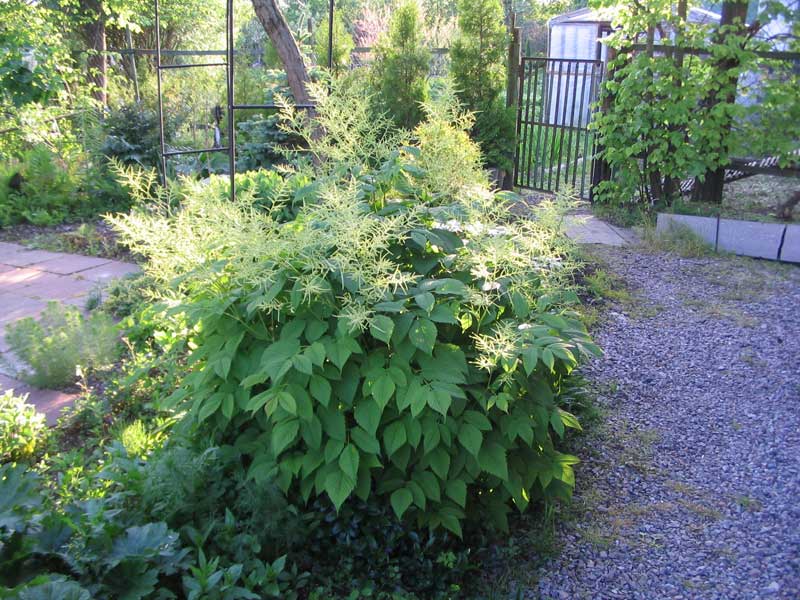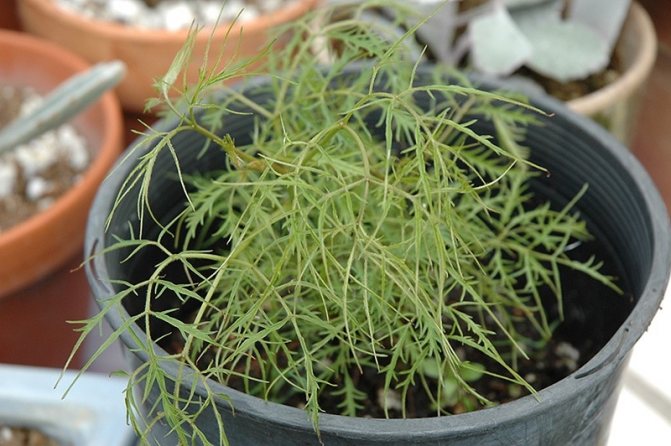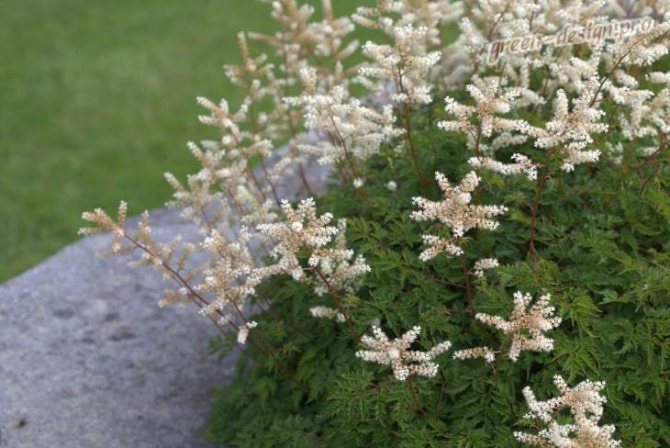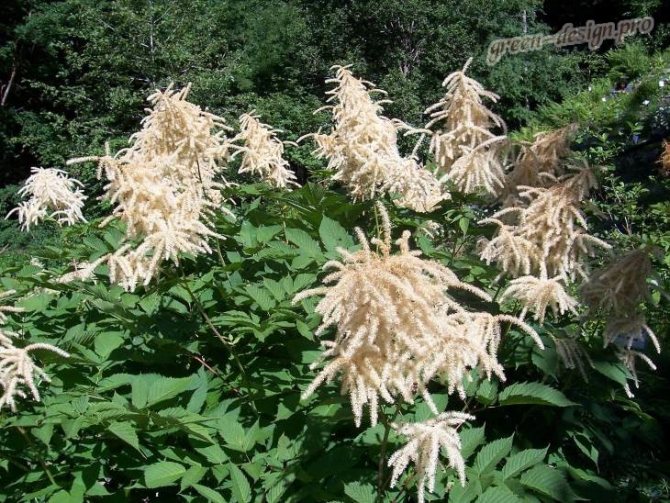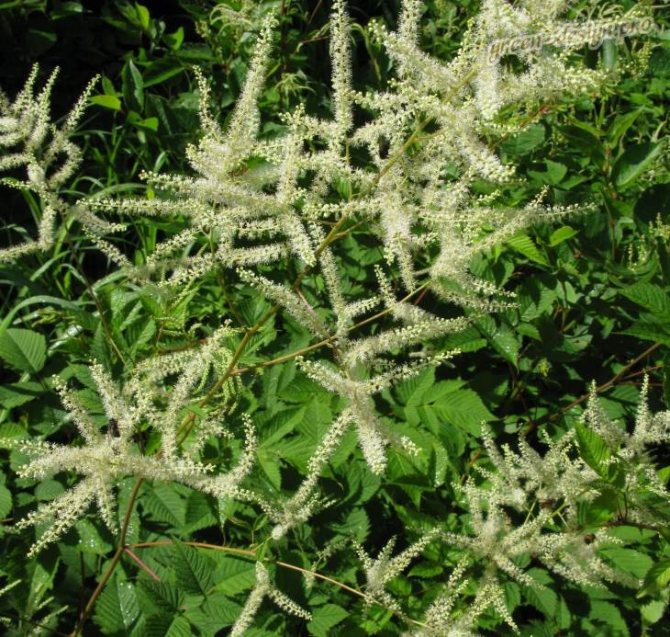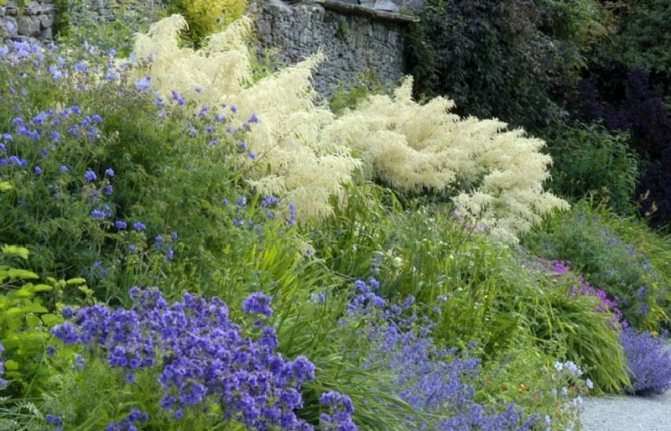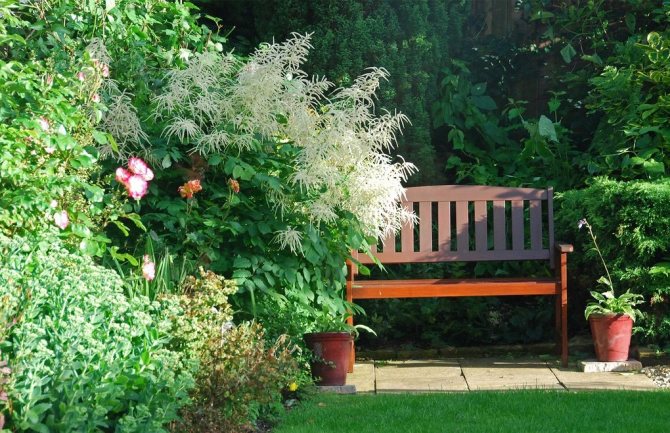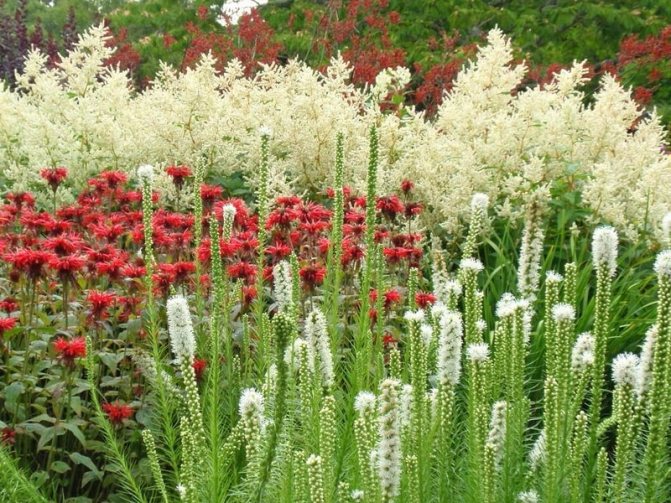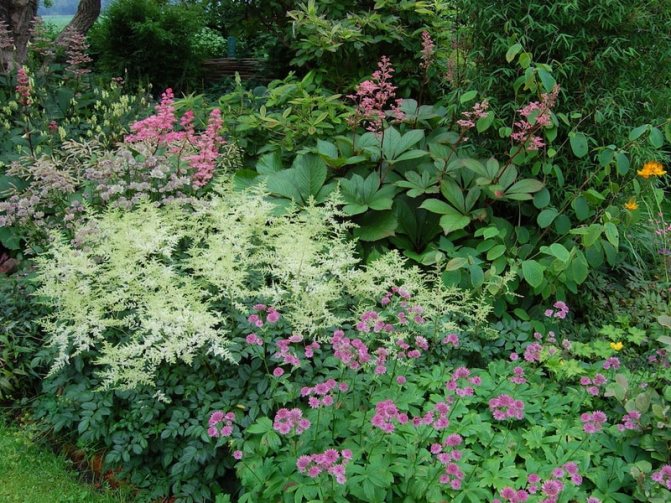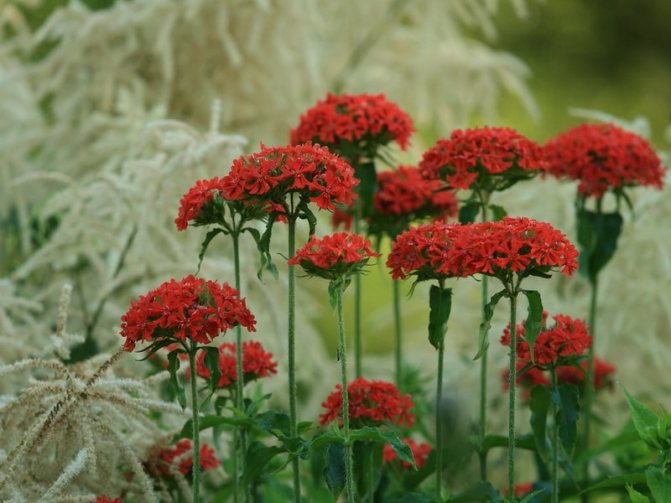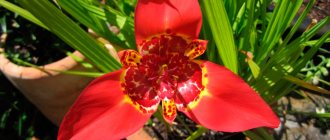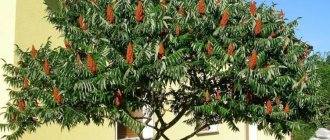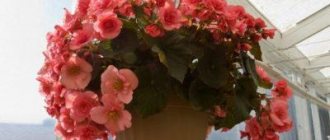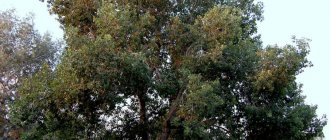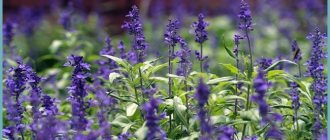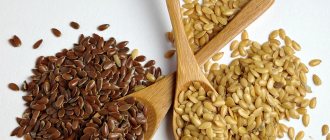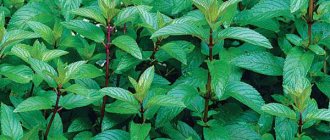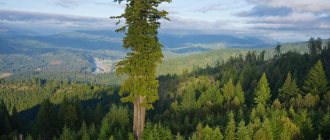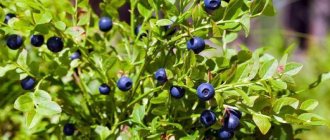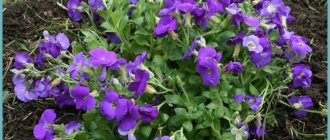Volzhanka (Aruncus) can also occur under a name similar to its transliteration - Aruncus. The plant is attributed by scientists to the Rosaceae family, or as it is also called Rosaceae. The genus in natural conditions can be found on the territory of the Northern Hemisphere, where a temperate climate prevails.
Preference is given to light undergrowth and forests, but this representative of the flora grows most of all in shade and on wet ground. Volzhanka is not uncommon in mountainous areas and subalpine zones. There are about 10-12 species in the genus of botanists.
| Family name | Pink or Rosaceae |
| Vegetative period of life | Perennial |
| Growth form | Herbaceous |
| Breeds | Seeds, cuttings or dividing the bush |
| Landing time in open ground | April-May |
| Planting recommendations | Saplings are placed at a distance of about 50 cm from each other |
| Priming | Nutritious, moist yet loose |
| Indicators of soil acidity, pH | 6.5-7 (neutral) |
| Illumination level | A wicked place |
| Humidity level | Abundant and regular watering, despite being moisture-loving, drought-resistant |
| Special care rules | Moisture-loving, organic fertilizing required |
| Height options | During the flowering period 1-1.5 m |
| Flowering time | From late May, June or early July |
| Type of inflorescences or flowers | Complex panicle inflorescences |
| Color of flowers | White or cream |
| Fruit type | Leaflet |
| The timing of fruit ripening | In September |
| Decorative period | Spring-autumn |
| Use in landscape design | As a specimen plant or in group plantings in flower beds and lawns, decoration of borders, walls or as hedges |
| USDA zone | 4–6 |
Most likely, Volzhanka got its scientific name because of the similarity of inflorescences with a goat's beard, which in Greek has a translation of the term "arynkos". But for the first time such a name for this representative of the flora was proposed by the famous flora taxonomist Karl Linnaeus (1707–1778) in his work “Opera Varia”. It happens that the people call him a "tovolzhnik".
All types of Volzhanka are perennials with a herbaceous form of growth. Also, plants are characterized by the presence of a thickened and branched rhizome located superficially. Gradually, over time, the root system lignifies and grows very strongly on the sides. When the time of flowering comes, the plant can reach heights of 1–1.5 m, however, in the first years, the growth over the growing season will not be too large. The total width of the aruncus bush is 1.2 m. The stems are upright and are formed quite strong, they have a greenish or reddish tint. Often there is so much deciduous mass that shoots can hardly be seen behind it. The foliage of the plant serves as a decoration for him, even when flowering has not yet begun. At the same time, it is noted that a bush of "goat beard" can grow such a number of leaves in just one season. Therefore, the plant is often mistaken for a large shrub. Skeletal shoots do not die off for the winter, but they lose their foliage.
Volzhanka leaf plates are very decorative, they have a complex, double or triple pinnately dissected shape. The scalloped edge adds attractiveness to the leafy lobes of the aruncus. The leaves are characterized by the absence of stipules. The color of the deciduous mass is a bright green or dark emerald hue.Leaves are attached to the stems along the entire length by means of elongated petioles.
In the process of flowering in Volzhanka, colorful complex panicle inflorescences begin to form on the tops of the stems, composed of a large number of small dioecious (only sometimes bisexual) sessile flowers. The flower stalks are 30-60 cm long. The color of the petals in the inflorescences can be whitish or cream, which is in sharp contrast to the darker color of the foliage. Male flowers are more lush and their arrangement is denser, while female flowers rarely grow, but at the same time they have an openwork edge.
Aruncus has a calyx with five lobes. The corolla is painted in white or pale yellow, it also has five petals. When fully opened, the diameter of the flower is 3 mm. The number of stamens in a flower can vary from 15-30 pieces. At the same time, the stamens in male flowers are longer than in female ones and are underdeveloped. The pistils are located freely, there are 3-5 of them, the column is bent. Male flowers have underdeveloped columns. The ovary has several ovules. Volzhanka begins to bloom with the arrival of summer or in early July. During this period, a tart pleasant aroma begins to spread over the plantings, attracting pollinating insects to the garden.
After the end of flowering in early September, the time for the formation of fruits comes in aruncus, represented by leaflets with a leathery pericarp. When the fruits are fully ripe, they open at the seam in the abdominal region. The leaflets are filled with very small seeds (almost dusty) with rod-shaped outlines.
A plant like Volzhanka does not require special complex care and even a novice gardener can handle it. However, if you make a little effort, then such landings will become a real decoration of the site.
Features of aruncus

Aruncus is a large herbaceous plant that is a perennial. During one season, he is able to build up a dense green mass. That is why most gardeners perceive it as a monumental shrub. In nature, it can often be found in the Northern Hemisphere in regions with a temperate climate.
The highly branched root system of this plant is superficial. With age, the diameter of the root system increases significantly, and the roots themselves woody. In autumn, with the onset of frost, the death of skeletal branches is not observed, but all the foliage flies around.
An adult bush has a height of 100 to 150 cm, and in diameter it reaches no more than 120 cm. However, a young aruncus does not grow very quickly. Powerful shoots are erect. The stems are completely covered with deep green leaves with carved edges, their petioles are long.
In the upper part of the branches, peduncles grow, which in length reach from 0.3 to 0.6 m. The branched spike-shaped inflorescence consists of many small sessile flowers of a cream or white color. Both female and male flowers form on the same bush. Female flowers are loosely arranged and have an openwork edge, while male flowers grow more densely and look more magnificent. In size, the flowers reach about 0.3 cm. They have a pale green tint due to the prominent perianths. Bushes bloom from June to early July. The flowers have a pungent tart aroma that attracts insects to the garden. In the first autumn weeks, fruits are formed, which are leaflets, inside of which are dust-like seeds.
We plant aruncus in the backyard
For growing Volzhanka dioecious, it is best to choose darkened areas with moist soil. This perennial crop grows well in the garden under the crown of fruit trees or on the banks of small ornamental garden ponds. The plant easily tolerates high humidity and constant darkening.The requirements for the ground at aruncus are minimal. She loves well-drained light soils.
Advice... But this plant should not be planted in the bright sun, since in this case the bush will grow poorly and will lose all its decorative effect.
Aruncus is planted in a pit measuring 50 by 50 centimeters. It is recommended for such a planting to use a fertile mixture of the top layer of soil and humus or compost. The distance between the planted bushes should be at least 80 centimeters, depending on the specific variety of this plant.
Reproduction of aruncus


Growing from seeds
Growing aruncus from seeds is easy, but harvesting mature seed is not easy. Pollination of flowers is complicated by the fact that the plant is dioecious. The very small leaflets contain dusty seeds.
Trim the inflorescence carefully and place it in a paper bag. There it should be until the moment, until it dries completely. After that, all the seeds are poured out of it.
Sowing seeds of aruncus is carried out in the first spring weeks, using large boxes filled with substrate. In southern regions with a mild climate, sowing is carried out directly into the open ground before winter. After the seedlings have formed 2 pairs of true leaf plates, they should be cut in such a way that the distance between them is from 10 to 15 centimeters. After 1 year, the grown seedlings are planted in open ground immediately to a permanent place. Do not forget to maintain a sufficient distance between the bushes.
Remember that after the plant is 2 years old, it will no longer be possible to transplant it. The fact is that its root system is lignified, and besides, it also grows strongly in width. The first time the bush blooms at 3 or 4 years.
Rhizome division
An adult bush is propagated by dividing the rhizome in the first spring weeks, before sap flow begins. Remove some of the roots from the ground and cut them off from the parent bush. Remember that the roots of the aruncus are woody, so you can only separate them with an ax or a very sharp knife. Each of the divisions should have filamentous roots and 1 or 2 buds. Cut sites should be treated with sulfur, wood ash or crushed charcoal. Immediately after this, land the segment in a new place, not allowing it to dry out. A bush that has grown from a cut often begins to bloom in the year of transplantation.
Interesting notes about the aruncus plant


Before Carl Linnaeus renamed Volzhanka it was called "barba caprae", such a phrase in Greek had the same translation "goat's beard". But it was decided to use the term "arynkos", which had the same designation.
Since the 17th century, gardeners have appreciated aruncus and began to use it as an ornamental plant. But at first, this representative has long been familiar to folk healers. And although the plant was not introduced into the pharmacopoeia of Russia, and official medicine does not apply it, but on the basis of numerous studies it was revealed that, for example, such a species as Volzhanka ordinary (Aruncus dioicus) is saturated with active substances, among which there are flavonoids, phenolic acids and hydroxycinnamic acids.
Thanks to these components, a dry extract is prepared from tavolzhnik, which has an antioxidant (helps to protect against diseases and aging), hepatoprotective (prevent the destruction of membranes and restore liver cells) and diuretic (reduce the water content in tissues) action. Therefore, Volzhanka has long been used to treat various diseases.
So the roots, foliage and flowers of aruncus were used to tone the body, fight fever, provide an astringent, choleretic and anti-dysentery agent.If you prepare an infusion of roots, then with its help angina and kidney diseases, colds and rheumatism, excessive urination and diarrhea are treated. Midwives gave such infusions to women in labor to stop bleeding after labor. Tinctures from the rhizome of Volzhanka will relieve swelling on the legs, and the crushed dried part is prescribed for pain in the kidneys. If sores appear on the skin, then healers advise to apply crushed fresh roots to a pasty state. If a person suffers from a strong cough, it was recommended to keep fresh, dried, soaked aruncus roots in the mouth.
On the territory of North America, the Indians are also familiar with the medicinal features of Volzhanka. So in the Cherokee tribe, drugs based on the plant eliminated stomach pains and bleeding, such remedies helped with bee stings. They treated gonorrhea and stomach pains with decoctions from the rhizomes of the tavolzhnik, used as a diuretic. In the Lumi tribe, healers prescribed to chew the raw foliage of aruncus for smallpox disease, and the Tringita Indians for blood diseases gave the patient a tincture from the roots, and for ulcers, the rhizomes were cleaned, crushed and applied to the affected skin.
Contraindications to the use of drugs based on Volzhanka have not yet been precisely identified, however, the exact dosage should be adhered to, otherwise the bust can provoke nausea. You should not use such funds at any month of pregnancy, breastfeeding and children under 10 years of age.
But not only for medicinal purposes it is customary to use aruncus, for example, on the territory of Sakhalin, young shoots of such a species as Aruncus asiaticus that have grown in spring are used for food. To do this, they are thoroughly soaked before use, and then boiled and rather tasty dishes are prepared.
Aruncus care


Aruncus is a shade-loving perennial, in which, in bright sunlight, the leaf plates dry out, and the growth of the shoots becomes slower. It grows well on any soil, but it must be watered systematically and abundantly. During active growth and flowering, it is recommended to feed it with organic matter. In the autumn, feeding is not carried out.
Do not forget to regularly cut off the inflorescences that have begun to fade. And in autumn, all shoots are shortened to about 50 mm. The surface of the soil near the plant for the winter is covered with a layer of mulch (peat and rotted leaves).
Aruncus is distinguished by its frost resistance, unpretentiousness and resistance to mechanical damage. It is also resistant to disease, but pests such as ticks, aphids and caterpillars can settle on it. You can get rid of them with a solution of an insecticidal drug (for example, Intavira or Aktelika) or a decoction of burdock.
Common varieties of Volzhanka
Aruncus is perennial a plant that grows quickly and can reach a height of 2 meters. Inflorescences have large panicles up to 50 centimeters long and 25 centimeters wide. Flowers of pastel colors, small with an elegant, delicate and pleasant scent. This shrub is different unpretentiousness in care, which allows even novice gardeners to successfully grow it. Currently, dozens of different varieties and hybrids of Volzhanka have been bred, which differ in their size, shape and shades of inflorescences. Excellent decorative properties all varieties of this plant differ. Therefore, regardless of the specific choice, the gardener will be able to decorate his personal plot with such a perennial shrub that does not require any care and special attention from him.
The most widespread today is the volzhanka dioecious dioxus, which differs large decorative leaves, and the height of the plant can reach two meters.Volzhanka usually begins to bloom on the first days of summer and lasts about a month.
We can also recommend that you pay attention to the variety Kneffy, which is characterized by a medium size shrub, usually not exceeding a height of 60 centimeters. Kneffi has white bed flowers and original leaves, which are divided into numerous sectors.
Volzhanka variety Horatio differs in the height of the stems not higher than 60 centimeters and the original red color of the stems of the flowers themselves. Of the features of the Horatio variety, we note its long flowering period, and with proper care, the plant will be able to sprout and bloom for 10 years or even more.
Types of aruncus with photos and names
Aruncus dioecious


In mid-latitudes in open ground, the most often cultivated aruncus dioecious, or ordinary. In nature, he prefers to grow in deciduous forests in shaded damp places. The height of this perennial plant can reach 200 cm. Its erect shoots are densely covered with foliage. A spreading plant in diameter often reaches more than 1.2 meters. On a long petiole, paired leaf plates grow, which are small in size. Since they are openwork, they look very much like fern foliage. The branched paniculate inflorescence has a length of about half a meter. This plant is dioecious, that is, it has male and female flowers, which are formed not on one, but on different peduncles. The bush blooms in June and July. Ripening of seeds is observed in September.
This species has the Kneifi variety, which is highly decorative. Its leaves are finely dissected and have a rich green color. Long leaf petioles have a drooping shape. The bush reaches a height of no more than 0.6 meters.
Aruncus asiatic


This plant can also reach two meters in height. Its foliage is dark green and rough. Complex paniculate inflorescences reach about 0.35 m in length and consist of snow-white flowers. The inflorescences are more lush than the previous species. The bush blooms in June, and its seeds fully ripen in the first days of September. This winter-hardy plant is found naturally in the northern regions.
There is an attractive variety called Fontana. A low bush (no more than 0.55 m) is decorated with drooping large paniculate inflorescences. Such aruncus prefers to grow in damp, shaded places and is often decorated with artificial and natural reservoirs. Flowering is observed in June – July.
Arunkus Kamchatka


In nature, this species can be found on the Aleutian and Kuril Islands, Kamchatka, Sakhalin and Alaska. It prefers to grow among forbs in meadows near mountain slopes or sea shores, and it also occurs on rocky embankments and rocks.
It is a dioecious perennial plant that can vary in height from 0.3 to 1.5 meters. The roots are lignified and thick. Cirrus double-dissected leaf plates are colored dark green, they are arranged in pairs on a long petiole. The length of the weakly branched compact paniculate inflorescence is about 0.2 m. Aruncus blooms in July – August. In the last days of September, the seeds ripen completely. This plant has an alpine subspecies, which is undersized (height about 0.3 m).
Aruncus American


Under natural conditions, it grows from North America to the Far East. In an adult plant, the height can reach 0.8–1.1 m. Its well-developed strong root system becomes 50–80 mm longer every year. The bush is actively forming lateral shoots, and it grows strongly in width.
Aruncus parsley, or etusifolius


This compact ball-shaped plant is about 25 centimeters tall.The branched snow-white inflorescences reach a height of about 0.6 meters, in shape they resemble dense finger-like stars. The bush blooms in mid-May, while the flowering duration is more than 4 weeks. During ripening, the seeds turn pale red, which, like the flowers, adorns the bushes. Openwork rich green leaf plates are finely dissected.
As a result of selection, the decorative hybrid "Perfection" was born. It reaches a height of no more than 0.3 m. Carved large sheet plates are painted in a deep green color. Snow-white inflorescences during seed ripening change their color to deep red.
American Aruncus (Aruncus americanus)
The homeland of this species are areas of North America. The plant reaches a height of one meter. Blooms from late May to mid June. This species is distinguished by a long rhizome, which lengthens by 7 cm every year. American Volzhanka forms less branched bushes than dioecious.
The leaves of this species are three times pinnate, have a light green tint. Inflorescences are small, white, shaped like spikelets. Volzhanka does not bloom as abundantly as the usual one, and therefore does not look as voluminous. Due to its low growth and compact bushes, this type of plant is very popular. Shrubs are often used for landscaping.
Volzhanka reproduces with the help of seeds, petioles or division of roots. For the formation of landscape design, it is better to choose reproduction by dividing the roots.
Important! When vegetative propagation, be sure to leave a few roots and at least one bud on each part of the bush. After dividing, individual parts of the bush must be immediately planted in the ground, otherwise the plant will die.
[collapse]
Aruncus in landscape design


Aruncus is grown as a solitary plant in lawns. Dwarf varieties are used to create borders in the local area or near a reservoir.
Also, this perennial is used in group plantings along with deciduous and coniferous trees, as well as shrubs. When planted in a flower bed, such a plant stops blooming too early. And annual varieties with spectacular bright inflorescences look great against a green background.
After cutting, the inflorescences do not stand for long. However, after drying, they retain their shape well and are suitable for formulating dry compositions.
Volzhanka in combination with other plants
Tall Volzhanka looks great in combination with low-growing plants, creating a bright white-green background for them.
Attention: when planting Volzhanka, it should be remembered that the bush, growing, can shade other plants.
Perfectly combined with Volzhanka:
- low astilbe;
- high delphiniums;
- spireas;
- large hosts;
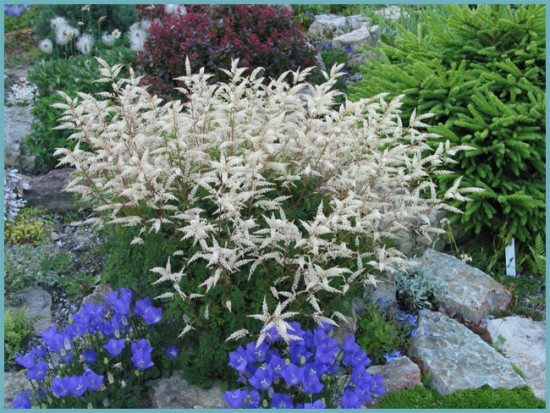

Volzhanka on a flower bed
- bought;
- barberry;
- shieldworm;
- sprawling fern;
- cotoneaster.
Watering and feeding
Water-loving Volzhanka should be watered often and abundantly (up to 30 liters of water under a bush), especially during dry periods, an adult plant is no exception. Aruncus grows a large amount of foliage, loses moisture very quickly.
The plant responds well to organic fertilizers; when planting, an average amount of compost or humus is introduced into a hole. In the future, you need to monitor the condition of the bush and prevent oppression. It is advisable to feed Volzhanka no more than 1 or 2 times (in spring and autumn), complex fertilizers and organic matter are suitable. However, it is worth remembering that oversaturation with nitrogen will lead to an increase in green mass and a lack of flowers.
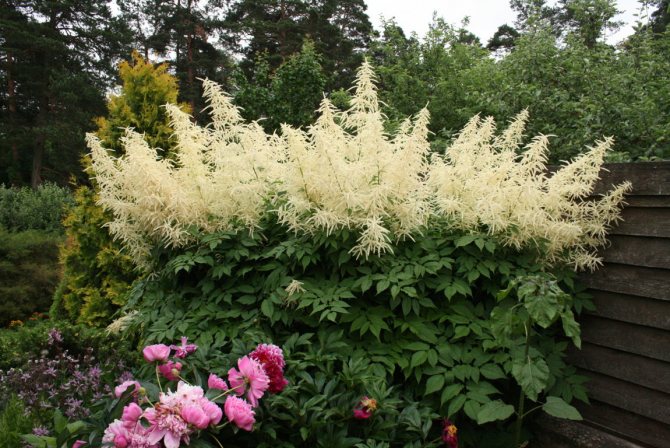

White and fluffy
Among shade-loving perennials, aruncus is the tallest and most spreading plant. The bush is formed by feathery leaves on long sturdy petioles. Light fluffy panicles of inflorescences up to half a meter long consist of miniature white and cream flowers.
Aruncus blooms from June to late July. In female plants, the inflorescences are openwork, loose.Inflorescences of male flowers are denser, thicker. Flowers are small, 2-3 mm in size.
The lace of leaves and the smooth swaying of the inflorescences in the wind give rise to the feeling that the bush is engulfed in a soft diffused glow. The gloomy corner of the garden comes to life and delights the eye.
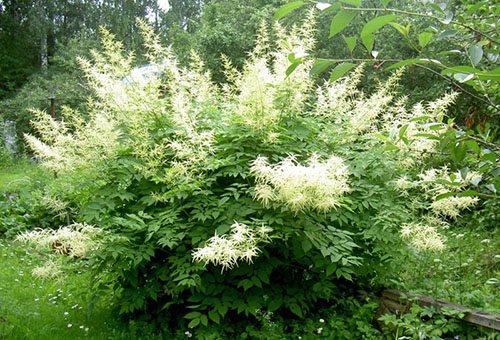

What is the plant afraid of?
It is not winter frosts that are terrible, but spring frosts. If young leaves or inflorescences hatch, they may freeze. There is no need to despair. Special care is not needed, the bush will recover from dormant buds.
The enemy of aruncus is the bright sun. If the plant is planted in an open area, the foliage turns pale, discolored, growth freezes, the inflorescences refuse to bloom.
The plant is resistant to disease. The sawfly poses a danger to the leaves. Its green caterpillars gnaw at the leaves from the back side, first leaving streaks, and then forming holes. Young leaves are eaten completely.
Advice
Digging, loosening, weeding in summer and autumn will help to get rid of the sawfly. If the lesion is difficult to stop, spraying will have to be applied.
Aphids and mites also attack willingly, but do not bring such damage to the plant.




